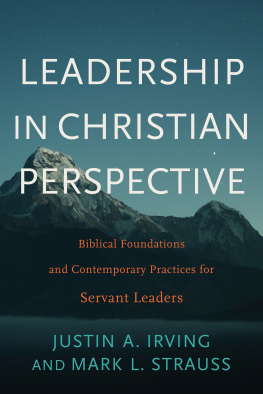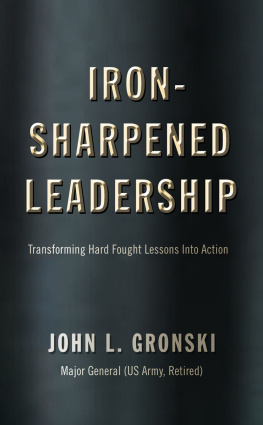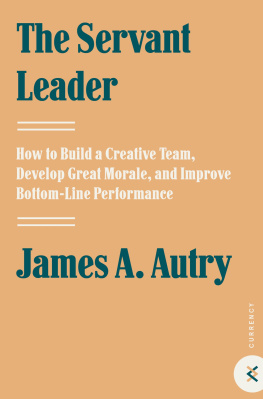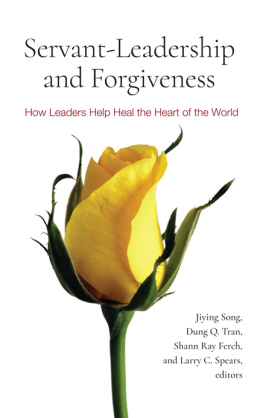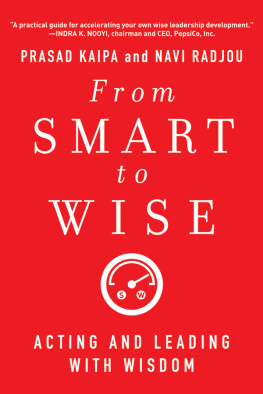

The Servant Leadership Series
Series Editor: Dr. Richard Kyte, Director of the D. B. Reinhart Institute for Ethics in Leadership and Endowed Professor of Ethics at Viterbo University
What Is Servant Leadership?
Servant leadership stems from the conviction that the best leaders are those who have a deep personal commitment to the common goodthat is, to the well-being of all and not just a fewand out of that commitment comes the desire to lead. What this means is that good leadership cannot be defined merely in terms of principles, techniques, or strategies; it is primarily a matter of character, originating in love and culminating in effective action. The foundational insight of servant leadership is that all leadership, properly understood, is an exercise of virtue and can be evaluated according to whether it leads to a flourishing life for individuals and communities. The practice of servant leadership seeks to inspire and engage people to work for the greater good every day.
The D. B Reinhart Institute for Ethics in Leadership
Since 1999, the D. B. Reinhart Institute for Ethics in Leadership at Viterbo University has brought people together in fruitful conversation about ethical ideas and issues, inspiring people to lead ethical lives while at the same time helping to develop leadership abilities to further the common good in communities and organizations.
Copyright 2022
Bernard L. Osborne
All rights reserved. No part of this book may be reproduced, stored in a retrieval system, or transmitted in any form or by any means, electronic, mechanical, photocopying, recording, or otherwise, without the prior written permission of the publisher.
Library of Congress Cataloging-in-Publication Data
Names: Osborne, Bernard L., author.
Title: Servant leadership from the middle / by Bernard L. Osborne.
Description: Wheat Ridge, Colorado : Fulcrum Publishing, [2022] | Includes
bibliographical references.
Identifiers: LCCN 2022010520 | ISBN 9781682753385 (paperback)
Subjects: LCSH: Servant leadership.
Classification: LCC HM1261 .O83 2022 | DDC 658.4/092--dc23/eng/20220310
LC record available at https://lccn.loc.gov/2022010520
Printed in the United States
0 9 8 7 6 5 4 3 2 1
Fulcrum Publishing
3970 Youngfield Street, Wheat Ridge, Colorado 80033
(800) 992-2908 (303) 277-1623
www.fulcrumbooks.com
To Mom and Dad
Contents
Faith dare the soul to go further than it can see.
William Clark
Foreword
The most common question I get from adult students is how to deal with a bad supervisor. The question rarely comes during class. It comes during a break or in a conversation after class. They dont want to ask the question in front of others.
But they are not alone. Most workers suffer under poor leadership of some sort. If they did not, employee engagement would be much higher than it is.
Being a good supervisor is not easy. Many employees are given some limited supervisory responsibilities relatively early in their careers, usually with no experience and little to no training. Whats more, some companies make it downright difficult to be a good leader when one is operating from the middle.
I had a conversation once with a factory manager who had just been chewed out by his boss. The problem? The manager wasnt staying in his lane. The employees he supervised felt respected and empowered. When employees from other parts of the company heard about this, they began coming to him for advice. Trying to be a good leader had made him stand outadmired by those on the factory floor, suspected by his peers in management.
This is not an unusual dilemma for managers: Is it better to stand out or to fit in? The answer, of course, depends on what kind of person one wants to be, how one wants to face life.
Bernard Osborne has written about his experience of learning to lead by facing deliberately upward and outward, in the direction of growth. This is every persons natural orientation, until resistance in its various forms pushes back, stunting our aspirations and forcing our attention downward and inward. Go along to get along becomes the unspoken mantra of too many unfortunate souls who never push through to their full potential.
A few of those who do push through may reach the top. When they write books about their experience they too often forget the doubts and uncertainties they struggled to overcome in the middle period of their lives. Thats understandable, because leadership at the top of an organization not only looks very different from leadership in the middle, if feels very different. There is much less resistance in giving orders downward than giving suggestions upward.
There are approximately 39,000 chief executive officers in the United States and an estimated 8 million managers (counting only large firms). There are millions more who have some sort of supervisory responsibilities. In other words, the vast majority of employees with some kind of leadership role in organizations are operating from the middle. They remain in the middle for the rest of their careers, and their influence on the well-being of their respective organizations is significantly underrated.
Gallup estimates that 70 percent of the variance in employee engagement scores within companies is due to managers. And yet, more often than not (82 percent of the time), companies select the wrong people to fill those roles. Why is that? Mainly, I think, because we are still beholden to a false distinction between managing and leading. Since we dont expect managers to be leaders, we dont look for the right traits in the people we choose to fill those roles, and we dont provide them with the right kind of guidance to develop into good leaders.
Everybody who takes on a leadership role wants to be a good leader. They want to be effective, to be a positive influence, but too often they do not know how. Many think real leadership has to wait until the next step up the ladder. They say to themselves: its something I can do in the future, when my career has advanced, when I get promoted, when I get that new job with more responsibility, more power.
But good leadership isnt about power; its about attitude. Its about looking upward and outward, about stretching and growing, learning and reflecting. Good leadership starts with an inward journey and culminates in outward influence.
Osborne reminds us that the best path when leading from the middle is to commit to the growth of others through the effects of positive influence. It is a kind of leadership that does not neatly correspond to organizational charts. It refuses to stay in its lane. It operates through the careful cultivation of trust and good will. It enriches the lives of those who commit to it and the lives of all those it touches.
Richard Kyte
March 10, 2022
Preface
Before I began writing this book, I did a Google search of books on leadership. Google returned 809,000,000 results in 1.05 seconds. Knowing this, you might ask yourself, why would anyone decide to write another book on leadership in an already oversaturated market? Or you might ask yourself, why should I, a new and emerging leader, use my precious spare time to read another book on leadership when so many have already been written by intelligent, accomplished, and proven leaders?
When most people think of successful leaders they typically think of a CEO, entrepreneur, college professor, philosopher, leadership coach, military officer, or a person high up in a hierarchy pyramid; someone in a position of power. Many of these people have in fact already written books on their leadership journey, sharing their profound wisdom and life experiences, and many have influenced not only my own leadership journey but those of countless others. With that said, I did not write this book pretending to be on their level or to compete with them. Instead, this book is sincerely written for those who I believe will benefit the most. It is written for those brave souls who have, or may decide to take the scary, uncertain, but noble and fulfilling first step up and out into a leadership position.
Next page


